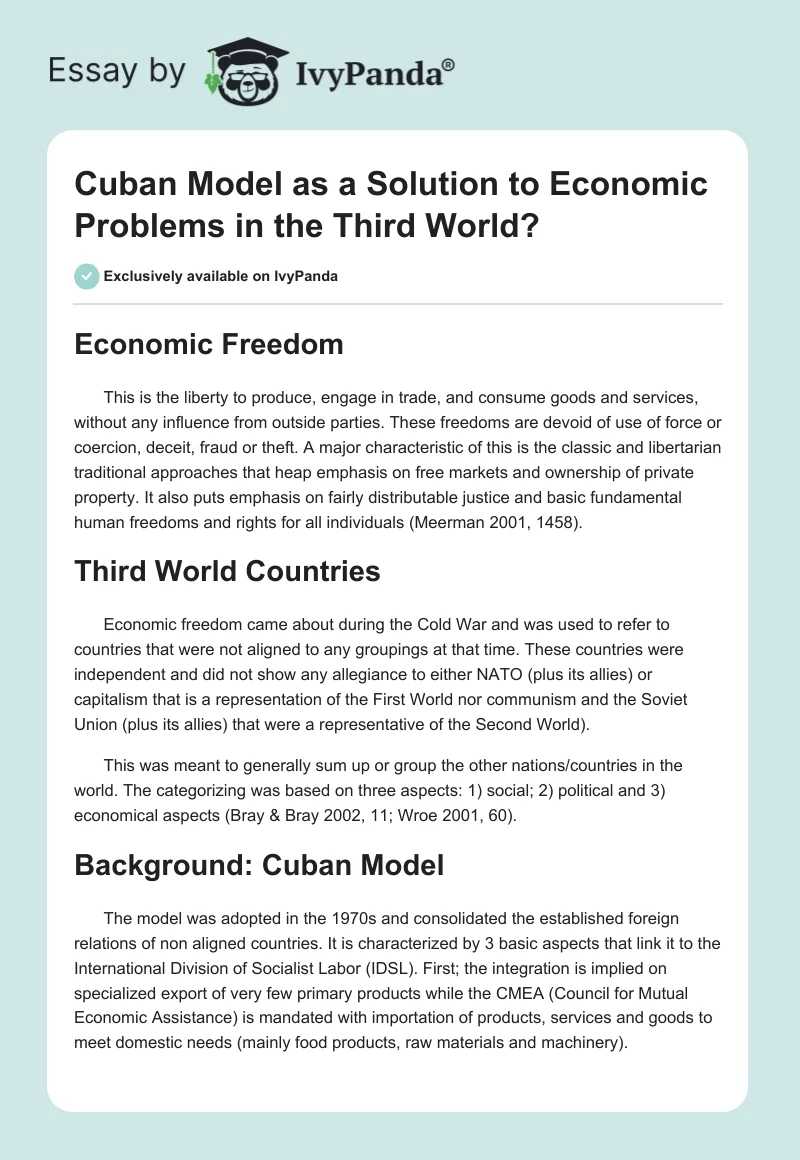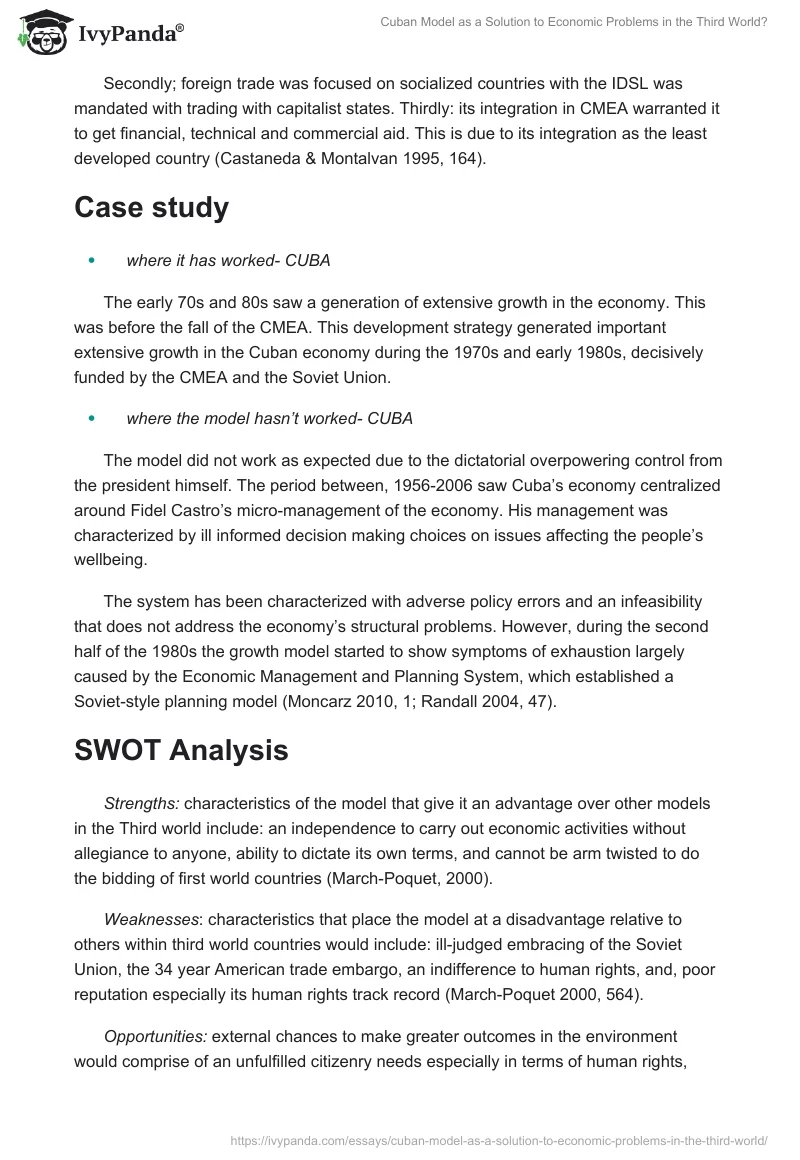Economic Freedom
This is the liberty to produce, engage in trade, and consume goods and services, without any influence from outside parties. These freedoms are devoid of use of force or coercion, deceit, fraud or theft. A major characteristic of this is the classic and libertarian traditional approaches that heap emphasis on free markets and ownership of private property. It also puts emphasis on fairly distributable justice and basic fundamental human freedoms and rights for all individuals (Meerman 2001, 1458).
Third World Countries
Economic freedom came about during the Cold War and was used to refer to countries that were not aligned to any groupings at that time. These countries were independent and did not show any allegiance to either NATO (plus its allies) or capitalism that is a representation of the First World nor communism and the Soviet Union (plus its allies) that were a representative of the Second World).
This was meant to generally sum up or group the other nations/countries in the world. The categorizing was based on three aspects: 1) social; 2) political and 3) economical aspects (Bray & Bray 2002, 11; Wroe 2001, 60).
Background: Cuban Model
The model was adopted in the 1970s and consolidated the established foreign relations of non aligned countries. It is characterized by 3 basic aspects that link it to the International Division of Socialist Labor (IDSL). First; the integration is implied on specialized export of very few primary products while the CMEA (Council for Mutual Economic Assistance) is mandated with importation of products, services and goods to meet domestic needs (mainly food products, raw materials and machinery).
Secondly; foreign trade was focused on socialized countries with the IDSL was mandated with trading with capitalist states. Thirdly: its integration in CMEA warranted it to get financial, technical and commercial aid. This is due to its integration as the least developed country (Castaneda & Montalvan 1995, 164).
Case study
- where it has worked- CUBA
The early 70s and 80s saw a generation of extensive growth in the economy. This was before the fall of the CMEA. This development strategy generated important extensive growth in the Cuban economy during the 1970s and early 1980s, decisively funded by the CMEA and the Soviet Union.
- where the model hasn’t worked- CUBA
The model did not work as expected due to the dictatorial overpowering control from the president himself. The period between, 1956-2006 saw Cuba’s economy centralized around Fidel Castro’s micro-management of the economy. His management was characterized by ill informed decision making choices on issues affecting the people’s wellbeing.
The system has been characterized with adverse policy errors and an infeasibility that does not address the economy’s structural problems. However, during the second half of the 1980s the growth model started to show symptoms of exhaustion largely caused by the Economic Management and Planning System, which established a Soviet-style planning model (Moncarz 2010, 1; Randall 2004, 47).
SWOT Analysis
Strengths: characteristics of the model that give it an advantage over other models in the Third world include: an independence to carry out economic activities without allegiance to anyone, ability to dictate its own terms, and cannot be arm twisted to do the bidding of first world countries (March-Poquet, 2000).
Weaknesses: characteristics that place the model at a disadvantage relative to others within third world countries would include: ill-judged embracing of the Soviet Union, the 34 year American trade embargo, an indifference to human rights, and, poor reputation especially its human rights track record (March-Poquet 2000, 564).
Opportunities: external chances to make greater outcomes in the environment would comprise of an unfulfilled citizenry needs especially in terms of human rights, arrival of new technologies, loosening of regulations, removal of international trade barriers, and the lifting of the 34 year trade embargo (Harris 1996, 121).
Threats: these are the external elements in the environment that could cause trouble for the model and may include: increase in trade barriers, perception of rival groupings and countries, shifts in country allegiances, emergence of substitute groupings and trade blocs (Berger 1994, 257).
Can it work as an economic solution to the third world?
The Cuban model cannot work since it has failed in Cuba, the country where it was adopted and meant to bring an economic revolution. The independence from trade and non allegiance from various groupings/blocs is a disadvantage as it locks out countries especially developing third world countries from advantages and perks from global trade blocs. Its form of sidelining capitalists/capitalism is a detriment to it (Hamilton 2002, 28)
Conclusion
The model should undergo a restructuring so as to be effective and efficient in Third World countries. There should be a consideration of engaging the positive attitudes and ideas of both capitalists and socialists to get a good mix of a near perfect economic model for third world countries to aid in their economic development. In addition to this, a reconsideration of fundamental human rights is very vital.
References
Berger, M., 1994. “The end of the Third World?” Third World Quarterly, 15(2): 257-75.
Bray, D. & Bray, M. W., 2002. “Introduction: The Cuban Revolution and World Change.” Latin American Perspectives, 29, p.3-17.
Castaneda, R. & Montalvan, G., 1995. “The “new” Cuban economic model (or socialism with Cuban characteristics).” CUBA IN TRANSITION, 5, p.154-190.
Hamilton, D., 2002. “Whither Cuban Socialism? The Changing Political Economy of the Cuban Revolution.” Latin American Perspectives, 29, p.18-39.
Harris, N., 1996. The End of the Third World. London: Penguin.
March-Poquet, J., 2000. “What Type of Transition is Cuba Undergoing?” Post-Communist Economies, 12 (1), p.564.
Meerman, J., 2001. “Poverty and mobility in low status minorities: the Cuban case in international perspective.” World development, 29(9), p.1457-1482.
Moncarz, R., 2010. “The Obama Administration and Latin America: A ‘New Partnership for the Americas.” Global Economy Journal, 10(1).
Randall, V., 2004. “Using and abusing the concept of the Third World.” Third World Quarterly 25(1): 42-53.
Wroe, A., 2001. “Poverty and mobility in low status minorities: the Cuban case in international perspective.” Economist, 339(7960).


